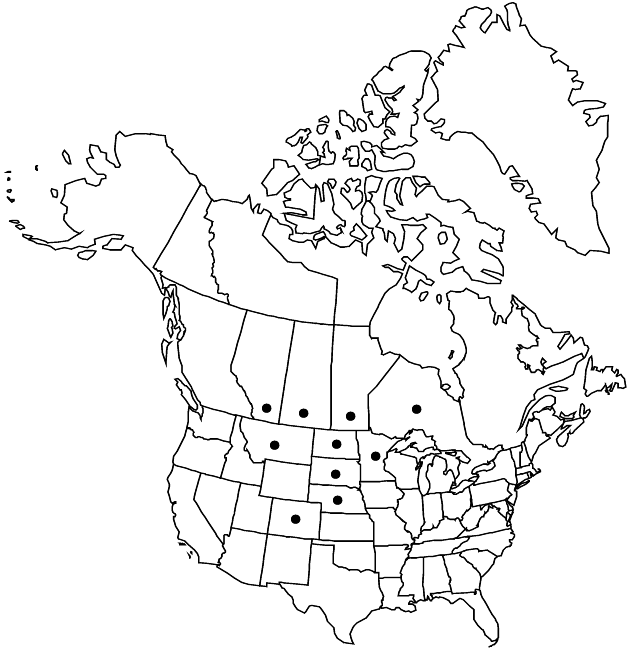Difference between revisions of "Heterotheca villosa var. ballardii"
Novon 4: 53. 1994.
FNA>Volume Importer |
FNA>Volume Importer |
||
| Line 7: | Line 7: | ||
|year=1994 | |year=1994 | ||
}} | }} | ||
| − | |basionyms={{Treatment/ID/ | + | |basionyms={{Treatment/ID/Basionym |
|name=Chrysopsis ballardii | |name=Chrysopsis ballardii | ||
|authority=Rydberg | |authority=Rydberg | ||
| + | |publication_title=Brittonia | ||
| + | |publication_place=1: 100. 1931 | ||
}} | }} | ||
|synonyms= | |synonyms= | ||
| Line 26: | Line 28: | ||
|elevation=300–2300 m | |elevation=300–2300 m | ||
|distribution=Alta.;Man.;Ont.;Sask.;Colo.;Minn.;Mont.;Nebr.;N.Dak.;S.Dak. | |distribution=Alta.;Man.;Ont.;Sask.;Colo.;Minn.;Mont.;Nebr.;N.Dak.;S.Dak. | ||
| − | |discussion=<p>Variety ballardii grows in the northeastern Great Plains; it is rare and probably introduced in Colorado, Montana, and northwestern Ontario. In its typical, large-leaved and many-rayed form, <i></i>var.<i> ballardii</i> is quite distinct. It is distinguished by its rounded leaf bases, indument of short hairs, eglandular, and large, many-rayed heads often subtended by one or more large, narrow, leaflike peduncle bracts. Plants of <i></i>var.<i> ballardii</i> are sufficiently similar to those of <i></i>var.<i> foliosa</i> that the two taxa might be treated as convarietal under the name <i></i>var.<i> foliosa</i>. V. L. Harms (2003) treated the Saskatchewan plants as members of a more broadly defined <i></i>var.<i> villosa</i>.</p> | + | |discussion=<p>Variety ballardii grows in the northeastern Great Plains; it is rare and probably introduced in Colorado, Montana, and northwestern Ontario. In its typical, large-leaved and many-rayed form, <i></i></i>var.<i><i> ballardii</i> is quite distinct. It is distinguished by its rounded leaf bases, indument of short hairs, eglandular, and large, many-rayed heads often subtended by one or more large, narrow, leaflike peduncle bracts. Plants of <i></i></i>var.<i><i> ballardii</i> are sufficiently similar to those of <i></i></i>var.<i><i> foliosa</i> that the two taxa might be treated as convarietal under the name <i></i></i>var.<i><i> foliosa</i>. V. L. Harms (2003) treated the Saskatchewan plants as members of a more broadly defined <i></i></i>var.<i><i> villosa</i>.</p> |
|tables= | |tables= | ||
|references= | |references= | ||
| Line 50: | Line 52: | ||
|publication year=1994 | |publication year=1994 | ||
|special status= | |special status= | ||
| − | |source xml=https://jpend@bitbucket.org/aafc-mbb/fna-data-curation.git/src/ | + | |source xml=https://jpend@bitbucket.org/aafc-mbb/fna-data-curation.git/src/f6b125a955440c0872999024f038d74684f65921/coarse_grained_fna_xml/V19-20-21/V20_546.xml |
|tribe=Asteraceae tribe Astereae | |tribe=Asteraceae tribe Astereae | ||
|genus=Heterotheca | |genus=Heterotheca | ||
Revision as of 18:43, 24 September 2019
Stems ascending to erect, 22–50 cm, moderately to densely strigose, eglandular, often abundantly long-hirsute. Distal cauline leaf blades oblong, (18–)22–34(–42) × 4.3–9.3(–12.5) mm, little reduced distally, bases rounded, margins flat, faces moderately strigose (hairs usually not obscuring faces, 20–56(–70)/mm2), eglandular. Heads (2–)4–16(–24), in corymbiform arrays. Peduncles (5–)12–47(–67) mm, moderately to densely hispido-strigose, eglandular; bracts subtending heads leafy, oblanceolate, often exceeding involucres. Involucres broadly campanulate, (5.5–)6.5–9.3 mm. Phyllaries narrowly triangular-lanceolate, moderately to densely strigose, eglandular to sparsely glandular, margins often reddish purple distally. Ray florets (12–)17–30 (avereaging 21), laminae (8.5–)9.9–14.5 mm (averaging 11.5 mm; showy). 2n = 36.
Phenology: Flowering (Jun–)Jul–Aug(–Oct).
Habitat: Dry sandy clay, thin silty loam, sandy loam, gravel soils, dry, rocky, granite-gravel soils, prairies, fields, roadsides, railroad rights-of-way
Elevation: 300–2300 m
Distribution

Alta., Man., Ont., Sask., Colo., Minn., Mont., Nebr., N.Dak., S.Dak.
Discussion
Variety ballardii grows in the northeastern Great Plains; it is rare and probably introduced in Colorado, Montana, and northwestern Ontario. In its typical, large-leaved and many-rayed form, var. ballardii is quite distinct. It is distinguished by its rounded leaf bases, indument of short hairs, eglandular, and large, many-rayed heads often subtended by one or more large, narrow, leaflike peduncle bracts. Plants of var. ballardii are sufficiently similar to those of var. foliosa that the two taxa might be treated as convarietal under the name var. foliosa. V. L. Harms (2003) treated the Saskatchewan plants as members of a more broadly defined var. villosa.
Selected References
None.